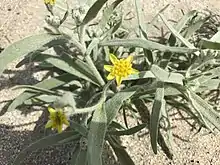Baileya pauciradiata
Baileya pauciradiata is a species of flowering plant in the daisy family which is known by the common names laxflower and Colorado desert marigold. It is native to the deserts of northwestern Mexico and the southwestern United States. It has been found in the States of California, Arizona, Nevada, Baja California, and Sonora.[1][2][3][4]
| Baileya pauciradiata | |
|---|---|
 | |
| Scientific classification | |
| Kingdom: | Plantae |
| Clade: | Tracheophytes |
| Clade: | Angiosperms |
| Clade: | Eudicots |
| Clade: | Asterids |
| Order: | Asterales |
| Family: | Asteraceae |
| Genus: | Baileya |
| Species: | B. pauciradiata |
| Binomial name | |
| Baileya pauciradiata | |
Description
Baileya pauciradiata is an annual or perennial herb with a gray-green downy stem branching to heights between 10 and 50 centimeters. The leaves are linear or lance-shaped and measure 4 to 14 centimeters long. Those at the base of the plant wither while those along the stem generally remain as the plant flowers.[1]
The inflorescence is composed of 2 or 3 flower heads. Each has a few three-lobed yellow ray florets around a center of yellow disc florets. The fruit is a club-shaped achene about half a centimeter long.[1]
Food source
This plant is the main food source for the sand dune dwelling moth Schinia pallicincta.[1]
References
- Flora of North America, Baileya pauciradiata Harvey & A. Gray, Mem. Amer. Acad. Arts, n. s. 4: 105. 1849
- Biota of North America Program 2014 county distribution map
- Calflora taxon report, University of California, Baileya pauciradiata A. Gray, Colorado Desert marigold, Lax Flower, laxflower
- Shreve, F. & I. L. Wiggins. 1964. Vegetation and Flora of the Sonoran Desert 2 vols. Stanford University Press, Stanford.
External links
- Jepson Manual Treatment
- United States Department of Agriculture Plants Profile
- Calphotos Photo gallery, University of California